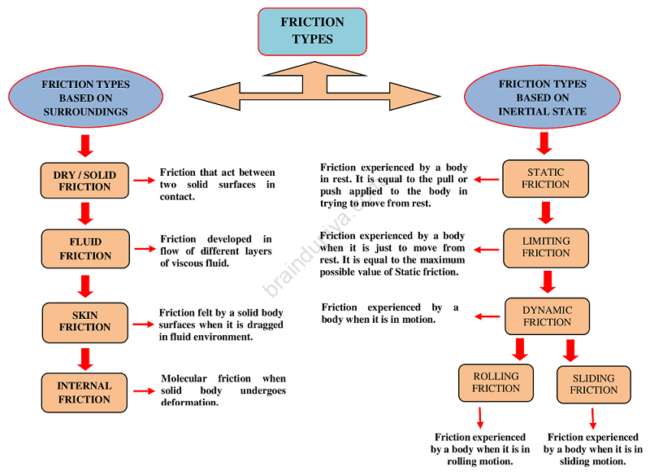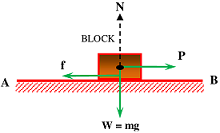What is Frictional Force?
Friction is a natural phenomenon which resists the motion of a solid material body upon another solid surface or liquid mass or gaseous atmosphere. Therefore, if there is a relative motion between two surfaces, a frictional force is exerted on the body in a direction opposite to the direction of movement of that body surface.
Frictional force comes to play in action when any solid body moves or tend to move –
- upon another solid surface
- in a liquid mass or
- in a gaseous atmosphere.
- Frictional force also occurs when, one liquid layer slides or tends to slide over another layer.
Therefore, frictional force is a natural phenomenon which resists the motion of a solid material body upon another solid surface or liquid mass or gaseous atmosphere. It always acts in a direction opposite the the direction of motion of surfaces.
Types of Frictional Forces
Depending upon the surfaces in interaction, the frictional force can be classified in following manner –
1) Dry Friction or Solid Frictional Force
This is the friction experienced between two contacting solid surfaces.
This is of two types –
- When a solid body is in rest it may have two types of friction –
- Static friction – This the lowest friction experienced by a body in rest.
- Limiting friction – This is the highest friction experienced by a body in rest.
- When a solid body is in motion, the friction is called dynamic friction or kinetic friction. It is of two types –
- Sliding friction – This is the friction when a body slides over another surface.
- Rolling friction – This is the friction when a body rolls over another surface.
2) Fluid Frictional Force
This is the force of friction experienced by fluid layers. It is also called as viscous force of friction.
3) Skin Frictional Force
This is the force of friction felt by a solid body surface when it is dragged in a fluid environment.
4) Internal Frictional Force
When a solid body undergoes deformation, then friction develops between its molecules. This is called molecular friction.
In a diagram, different types of friction can be represented as given below –

Dry Friction or Solid Friction
Dry friction or Solid friction acts between two solid surfaces which are in contact.
It is the most common type of friction experienced by us in our daily life. It is further classified depending upon the state of rest or motion of body as follows –
When a solid body is in rest, it may have two types of friction –
(i) Static friction

Consider about a body of weight ( W ) resting on a horizontal rough plane AB . Let, a pulling force ( P ) is applied in to move the body.
Consider that, initially the pull ( P ) is so small such that it doesn’t move. In this condition the body is said to be in static equilibrium in the state of rest. The effect of applied pulling force ( P ) is neutralizes by force of friction ( f ) developed between body surface and plane AB as shown in figure.
Since the body is in static equilibrium, hence the developed frictional force ( f ) is called Static friction.
Now consider that, the applied pull ( P ) is increased by small amount such that body doesn’t move. In this case also the effect of increased applied force of pull ( P ) is balanced by the increased force of friction ( f' ) between body and plane.
In this way, if we go on increasing the pull ( P ) , the developed frictional force ( f ) also goes increasing and resisting the movement of body.
This means that the magnitude of static friction acting on a body at rest is equal to the applied force on that body.
Therefore, Magnitude of static friction = Magnitude of applied force to move the body from rest.
(ii) Limiting friction
By increasing the pulling force, a situation will arise when the the force become ( P_{limit} ) and body is just at the point of motion. In this situation the developed frictional force ( f_{limit} ) , will be the maximum possible value of static friction. This is called Limiting friction.
Therefore, Limiting Friction = Maximum possible value of static friction required for a combination of surfaces in contact before body starts to move.
Kinetic friction
When a solid body is in motion, it will have Dynamic or Kinetic friction.
If the pulling force is further increased just a little more from ( P_{limit} ) , the body commences to move on the surface. The amount of friction now experienced by the body is called dynamic friction or kinetic friction.
Now, the body has started to move and continue to move under the action of pull ( P' ) which is now just greater than the value of ( P_{limit} ) .
If the pull ( P' ) is just decreased a little bit to the value ( P_{limit} ) or below it, then the body should come to rest. But it not happens. It is seen that body still continues to move on though value of pull is now considerably less than the value of pull ( P_{limit} ) at limiting frictional force.
This implies that, friction acting on a moving body is lower than the friction acting on body when it is in the state of rest or just to move.
Therefore, kinetic friction is always less than limiting friction or maximum static friction for a given pair of surfaces in contact.
Kinetic friction is of further classified in two types –
(i) Sliding Friction –
When a body slides or tends to slide on another surface, the developed friction is called Sliding friction.
(ii) Rolling Friction –
When a body rolls or tend to roll on a surface, the developed friction is called Rolling friction.
In general sliding friction is always greater than rolling friction between same pair of contact surfaces. This is the reason that, to move a wooden log, it is always easier to roll it in comparison to drag it on the surface.
Fluid friction
Friction developed in the flow of different layers of a fluid is called fluid friction.
As the fluid viscosity increases, fluid friction also increases.
Skin friction
When a body is dragged in a fluid or gaseous environment, the felt friction is called Skin friction.
Movement of hydroplanes, boats, submarine, air planes etc. experience this type of friction.
Internal friction
When a solid body undergoes deformation under the action of a load, molecular friction comes to play which resist the deformation. This is called internal friction.
Comparison between different Frictional Forces
Suppose, a body is at rest on a surface. A force is applied on this body to move. Different types of frictional forces will develop at different stages of body from rest to motion.
Different types of frictional forces acting on the body is represented in an illustrative diagram as shown –

Following points should be noted.
- Static friction and limiting frictions act when the body is in rest.
- Limiting friction is the highest possible value of static friction.
- Rolling friction and sliding frictions act when the body is in motion. These are also called dynamic frictions.
See numerical problems based on this article.
